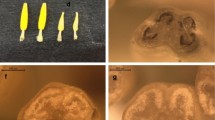Summary
A study was made of the restoration of fertility in cytoplasmic male sterile petunia. The fertility expression of plants with restorer genes in sterilizing cytoplasm proved quite dependent upon environmental conditions, especially temperature. In experiments with clones at a series of constant temperatures in the phytotron fertility appeared to follow an optimum curve, the position of the optimum and the width of the fertility range depending upon the number of restorer genes present. On the basis of the phytotron data a preliminary genetical analysis could be made for a part of the material. Restoration of fertility appeared to be governed by at least three factors: a major gene Rf 1, an accessory gene rf 2, and a gene or complex of genes referred to as Rf 3.
Samenvatting
Een onderzoek werd verricht naar de achtergronden van fertiliteitsherstel bij plasmatisch mannelijk steriele petunia. Hierbij is gebleken, dat de fertiliteitsexpressie van planten met fertiliteit-herstellende genen in steriliserend plasma in sterke mate afhankelijk is van de uitwendige omstandigheden, in het bijzonder van de temperatuur. Bij proeven met klonen, blootgesteld aan een reeks van constante temperaturen in het fytotron, bleek de fertiliteit te verlopen volgens een optimumkromme. De ligging van het optimum en de breedte van het fertiliteitstraject bleek afhankelijk van het aantal aanwezige fertiliteit-herstellende genen. Met behulp van de fytotron-gegevens kon voor een gedeelte van het bij het onderzoek betrokken materiaal een voorlopige genetische analyse worden uitgevoerd. Herstel van fertiliteit leek te berusten op tenminste drie factoren, de hoofdfactor Rf 1, een accessorische factor rf 2, en een factor of factorencomplex aangeduid als Rf 3.
Similar content being viewed by others
References
Bandlow, G., 1964. Die pollensterilität von Beta vulgaris und deren Artbastarden sowie ihre Verwertung in der Zuckerrübenzüchtung. Z. Pflanzenz. 52: 160–240.
Barham, W. S. and Munger, H. M., 1950. The stability of male sterility in onions. Proc. Am. Soc. hort. Sci. 56: 401–409.
Bianchi, F., 1963. Transmission of male sterility in Petunia by grafting. Genen Phaenen 8: 53–64.
Cortessi, H. A., 1967. Investigations made into male sterile beets. Euphytica 16: 425–432.
Duvick, D. N., 1959. The use of cytoplasmic male sterility in hybrid seed production. Econ. Bot. 13: 167–195.
Duvick, D. N., 1966. Influence of morphology and sterility on breeding methodology. Plant Breeding 1st ed., Univ. Press, Ames, Iowa, pp. 85–139.
Edwardson, J. R. and Warmke, H. E., 1967. Fertility restoration in cytoplasmic male-sterile petunia. J. Hered. 58: 195–196.
Ferwerda, F. P., 1963. Cytoplasmatische mannelijke steriliteit bij Petunia. Genen Phaenen 8: 33–35.
Frankel, R., 1962. Further evidence on graft induced transmission to progeny of cytoplasmic male sterility in Petunia. Genetics 47: 641–646.
Hamilton, B. A., 1962. A study of cytoplasmic male sterility and male fertility restoration in Petunia. Thesis in Hort., Penn. State Univ., pp. 97.
Hamilton, B. A., 1965. A cytological study of temperature-cytoplasmic-genetic interactions in a fertility restorer line in Petunia. Diss. Penn. State Univ., pp. 93.
Hansche, P. E. and Gabelman, W. H., 1963. Phenotypic stability of pollen sterile carrots, Daucus carota L. Am. Soc. hort. Sci. 82: 341–350.
Jones, H. A. and Clarke, A. E., 1943. Inheritance of male sterility in the onion and the production of hybrid seed. Proc. Am. Soc. hort. Sci. 43: 189–194.
Kidd, H. J., 1961. The inheritance of restoration of fertility in cytoplasmic male-sterile Sorghum. Sorghum Newsl. 4: 47–49.
Lichter, R. und Muendler, M., 1961. Untersuchungen über die Pollensterilität der Küchenzwiebel (Allium cepa L.) insbesondere über den Einfluss von Witterung und genetischer Konstitution. Z. Pflanzenz. 45: 393–405.
Marrewijk, G. A. M. van, 1968. Plasmatische mannelijke steriliteit en fertiliteitsherstel bij de petunia. Meded. Landbouwhogeschool, Wageningen 68, No. 16: 129 pp.
Meyer, V. G. and Meyer, J. R., 1965. Cytoplasmically controlled male sterility in cotton. Crop. Sci. 5: 444–448.
Nieuwhof, M., 1968. Effect of temperature on the expression of male sterility in Brussels sprouts (Brassica oleracea L. var. gemmifera DC.). Euphytica 17: 265–273.
Owen, F. V., 1945. Cytoplasmically inherited male-sterility in sugar beets. J. agric. Res. 71: 423–440.
Rohrbach, U., 1965. Beiträge zum Problem der Pollensterilität bei Beta vulgaris. L. III. Untersuchungen über die Wirkung der Umwelt auf den Phänotyp des Merkmals Pollensterilität. Z. Pflanzenz. 54: 111–130.
Author information
Authors and Affiliations
Rights and permissions
About this article
Cite this article
Van Marrewijk, G.A.M. Cytoplasmic male sterility in petunia. I. Restoration of fertility with special reference to the influence of environment. Euphytica 18, 1–20 (1969). https://doi.org/10.1007/BF00021977
Received:
Issue Date:
DOI: https://doi.org/10.1007/BF00021977




